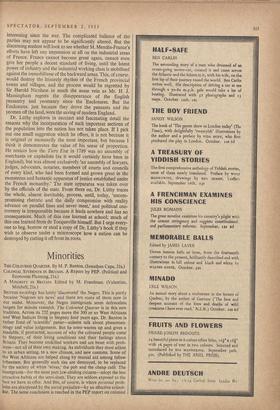Minorities
A MINORITY IN BRITAIN. Edited by M. Freedman. (Valentine, Mitchell, 21s.)
Barris!' sociology has lately 'discovered' the Negro. This is partly because 'Negroes are news' and there are more of them now in our midst. Moreover, the Negro immigrants seem defenceless targets for minute research. Tile Coloured Quarter is in this new tradition. Across its 252 pages move the 300 or so West Africans and West Indians living in Stepney four years ago. Dr. Banton is rather fond of 'scientific' patter—solemn talk about phenomen- ology and value judgements. But he soorP warms up and gives a readable, if protracted, account of why the coloured people come lo Stepney, of their living conditions and their feelings about Britain. They become unskilled workers and are beset with prob- lems—not all of their own making. As individuals they must adjust to an urban setting, to a new climate, and new customs. Some of the West Africans are helped along by mutual aid among fellow tribesmen. But generally such ties are destroyed, to be replaced by the society of white 'wives,' the pub and the cheap café. The immigrants—for the most part law-abiding citizens—adopt the less attractive habits of the semi-slum. They are seldom exposed to the best we have to.offer. And this, of course, is where personal prob- lems are sharpened by the social prejudice—by an effective colour- bar. The same conclusion is reached in the PEP report on colonial
students (which has been previously mentioned in these columns). Both Dr. Banton and the PEP Report admit that the coloured population has its own irrational fears and hates. But this, they rightly insist, is no excuse for our own ignorance or unreason. The Negro student may not resent our views on intermarriage; but neither he nor the Negro navvy will forget those foolish questions about 'life in the jungle.'
The Minority' in the book edited by Mr. Freedman is the Jewish minority. His contributors include Dr. James Parkes on the history of Anglo-Jewry, Dr. H. Neustatter who courageously assembles the scattered statistics, and Dr. Brotz, an American, who offers slight, but amusing, impressions of Jewish life in Lon- don. Mr. Freedman himself has added a most lucid essay in which he not only describes the pattern of Jewish life in transition but also asks : what does this pattern tell us about the larger society of Britain? Obviously the position of 'minorities' (especially the more developed and assimilated minorities like Anglo-Jewry) sheds light on the subtleties of status found among the 'majority.' Thus Mr. Freedman notes the strength of Jewish solidarity found even among 'atheist' Jews. Such solidarity thrives upon prejudice or persecution. Yet the survival of a distinct Jewish minority may owe more to a genuine British tolerance for social eccentricity. So, suggests Mr. Freedman, by making facilities for 'being different' so readily available, the Gentiles 'encourage' the Jews to survive —and this encouragement marks a certain reluctance to admit 'the outsider' into full equality of status. Such ambivalence surely exists—even if its extent is not known; and it is to Mr. Freedman's credit that he explores it with such delicacy and humour.
JULIUS GOULD



































 Previous page
Previous page